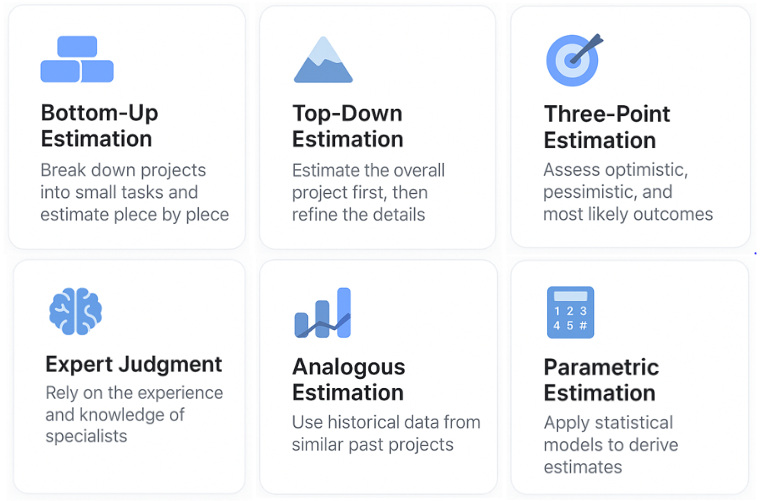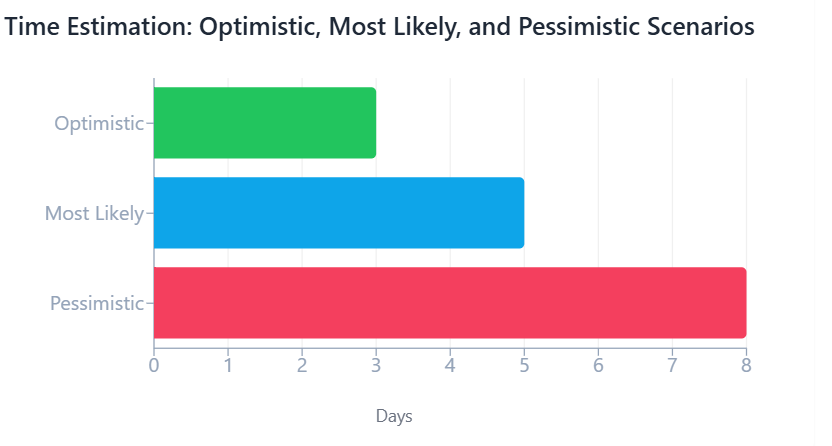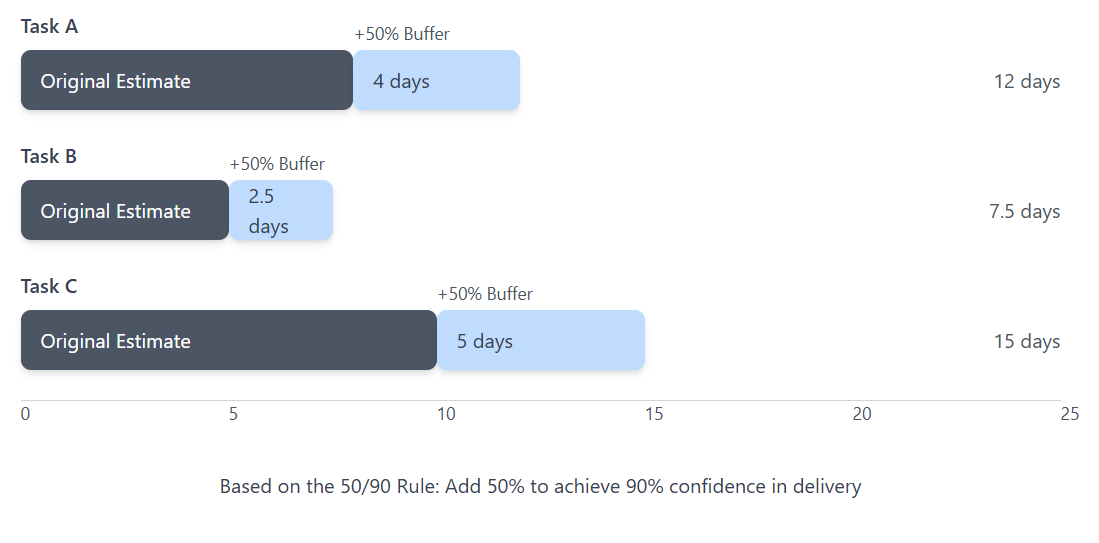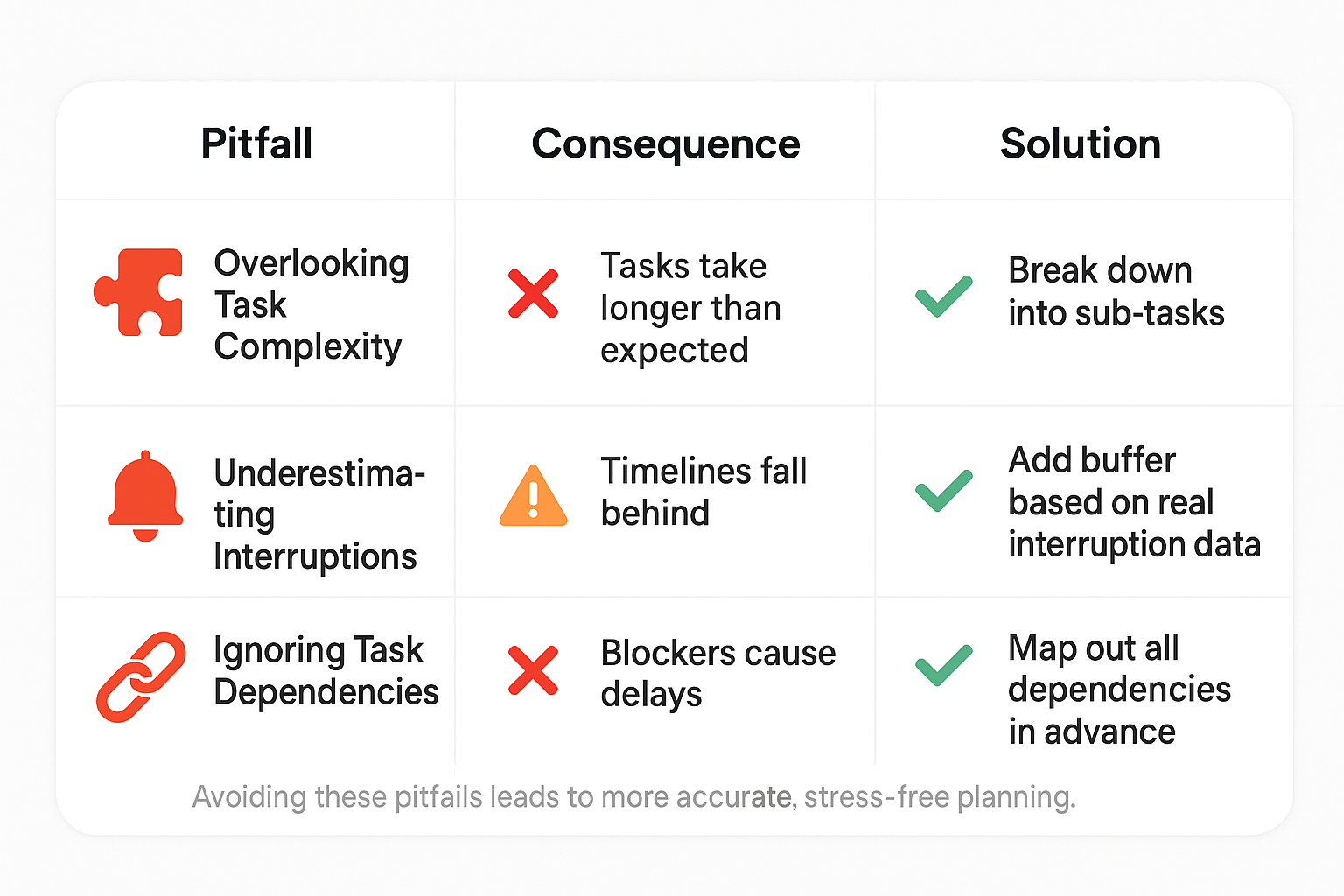When it comes to managing your time, knowing how to estimate how long a task will take to complete can feel like having a superpower.
Did you know that the average person spends 47% of their day thinking about something other than the task at hand? No wonder time estimation is tricky!
Estimating task duration accurately helps you avoid bottlenecks, keeps projects on track, and improves productivity. Interestingly, scientists have found that we tend to underestimate how long something will take, a cognitive bias known as the "planning fallacy."
In this article, we will explore:
- Six powerful techniques to estimate time with precision
- Key factors that influence the accuracy of your time estimates
- Buffer time and contingencies to safeguard your timeline from delays
- Best tools and software to enhance your time estimation accuracy
- Common mistakes that can derail your time estimates and project schedules
How Long Should Each Task Take to Complete?
Estimating the exact time is both an art and a science. It requires a blend of experience, analytical thinking, and sometimes a bit of intuition.
Let's explore six powerful techniques that can help you master the art of time estimation.

1. 🧱 Bottom-Up Estimation: Building from the Ground Up
Imagine you're building a house. You wouldn't just guess how long it would take, right? You'd break it down into smaller tasks: laying the foundation, framing the walls, installing the roof, and so on. That's exactly what Bottom-Up Estimation is all about.
How it works:
- Break your project into the smallest possible tasks
- Estimate the time for each mini-task
- Add up all the estimates
Pro Tip: Use a simple spreadsheet to list all tasks and their estimates. It's satisfying to see your project come together piece by piece!
When to use it:
- For complex projects with many components
- When you need a highly detailed project plan
- If you're working with a team and can delegate estimation of different parts
2. 🏔️ Top-Down Estimation: The Bird's Eye View
Now, let's flip our perspective. Top-down estimation is like looking at your project from a mountaintop. You see the big picture first, then work your way down to the details.
How it works:
- Start with the overall project goal and timeline
- Break the project into major phases or deliverables
- Allocate time to each phase based on the total estimate
Analogy:
Think of it like planning a road trip. You decide on your destination and total travel time, then break it down into daily driving segments.
When to use it:
- For quick, high-level estimates
- When you have limited information about project details
- In the early stages of project planning
3. 🎯 Three-Point Estimation: Embracing Uncertainty
Life is full of uncertainties, and so are projects. Three-Point Estimation acknowledges this by considering best-case, worst-case, and most likely scenarios.
How it works:
- For each task, estimate:
- Optimistic time (O): Best-case scenario
- Pessimistic time (P): Worst-case scenario
- Most likely time (M): Realistic scenario
- Use the formula: (O + 4M + P) / 6
Visualization:

Calculation: (3 + 4*5 + 8) / 6 = 5.17 days
When to use it:
- When dealing with unfamiliar tasks
- In projects with many unknowns
- To provide a range of estimates to stakeholders
4. 🧠 Expert Judgment: Tapping into Collective Wisdom
Sometimes, the best tool we have is the experience of those around us. Expert Judgment leverages the insights of seasoned professionals who've "been there, done that."
How it works:
- Identify experts in relevant areas
- Present them with the task or project
- Collect their time estimates and rationale
- Synthesize the information into a final estimate
Pro Tip: Use techniques like Planning Poker in Agile environments to make expert judgment more interactive and fun!
When to use it:
- For unique or specialized tasks
- When historical data is limited
- To validate estimates from other methods
5. 📊 Analogous Estimation: Learning from the Past
Why reinvent the wheel? Analogous Estimation looks at similar past projects or tasks to inform current estimates.
How it works:
- Identify a similar past project or task
- Adjust the previous timeline based on differences in complexity, scale, or resources
Example:
If a similar website took 4 weeks to build, but the current project has 25% more features, you might estimate 5 weeks (4 weeks * 1.25).
When to use it:
- When you have a history of similar projects
- For quick, rough estimates
- In the early stages of project planning
6. 🔢 Parametric Estimation: When Numbers Tell the Story
For the data lovers out there, Parametric Estimation uses statistical relationships between historical data and other variables to calculate an estimate.
How it works:
- Identify the parameter to measure (e.g., lines of code, number of rooms to paint)
- Determine the rate (e.g., hours per line of code, hours per room)
- Multiply the parameter by the rate
Example:
If painting one room takes 2 hours on average, and you need to paint 5 rooms:
Estimate = 2 hours/room * 5 rooms = 10 hours
When to use it:
- For repetitive tasks or projects
- When you have reliable historical data
- In industries with standardized outputs (e.g., construction)
Remember, these techniques aren't mutually exclusive. The best estimators often use a combination of methods, adapting their approach to the unique needs of each project. Practice, learn from your experiences, and don't be afraid to refine your estimates as you gather more information.
Factors to Consider When Estimating Time: Key Insights for Accurate Predictions
When it comes to estimating how long a task or project will take to complete, it's not just about picking a number out of thin air.
Accurate time estimation is a skill that requires careful consideration of various factors. Let's dive into four crucial elements that can make or break your time estimates.
1. Complexity of the Task
Task complexity is a primary determinant of how long something will take to complete. Think of it as the difference between assembling a simple bookshelf and building an entire house from scratch.
When assessing task complexity, consider:
- Number of steps involved: Generally, the more steps a task has, the longer it will take. Break down the task into its component parts to get a clearer picture.
- Skill level required: Does the task require basic skills that most team members possess, or does it demand specialized expertise? Higher skill requirements often translate to longer completion times, especially if training is needed.
- Novelty of the task: Familiar tasks are usually quicker to complete than entirely new ones. If you're venturing into uncharted territory, allow extra time for learning and problem-solving.
2. Available Resources
The resources at your disposal can dramatically affect how quickly a task can be completed. Think of resources as the tools and ingredients you need to get the job done.
Key resources to evaluate include:
- Team Size: Having more people can speed up certain tasks, but be cautious - adding too many people to a project can sometimes slow things down due to increased coordination needs.
- Skill Sets: Having team members with the right expertise can significantly accelerate task completion. Assess whether you have the necessary skills in-house or if you'll need to factor in time for training or hiring.
- Tools and Technology: The right tools can be game-changers for efficiency. Consider whether you have access to all the necessary software, hardware, or other equipment needed for the task.
- Budget: Sometimes, allocating more funds to a task can shorten timelines. This could mean hiring additional help, purchasing better tools, or outsourcing certain aspects of the project.
When assessing resources, ask yourself: Do we have enough people with the right skills? Do we have the necessary tools? Can we allocate additional resources if needed?
3. Dependencies and Potential Bottlenecks
In project management, tasks rarely exist in isolation. Dependencies between tasks can significantly impact your timeline.
Types of dependencies to consider:
- Finish to Start: Task B can't begin until Task A is complete. This is the most common type of dependency.
- Start to Start: Task B can't start until Task A has begun.
- Finish to Finish: Task B can't finish until Task A is complete.
- Start to Finish: Task B can't finish until Task A has started (less common).
Identifying potential bottlenecks is crucial. Look for:
- Tasks that many other tasks depend on - these are often critical path items.
- Resources that are in high demand but short supply.
- External factors, like client approvals or deliveries from third-party vendors.
4. Historical Data and Past Experiences
Learning from the past is one of the most powerful tools for accurate time estimation. Historical data and past experiences provide real-world context for your estimates.
Ways to leverage historical information:
- Review Similar Past Projects: Look at how long similar tasks or projects took to complete in the past. Were the initial estimates accurate? If not, why?
- Analyze Patterns: Look for consistent overruns or underestimates in certain types of tasks. This can help you adjust your current estimates more accurately.
- Consider Team Growth: Has your team's skill level improved since past projects? This could mean tasks might be completed faster now.
- Personal Experience: Your own intuition based on past work can be invaluable. Trust your gut, but verify with data when possible.
- Team Wisdom: Don't hesitate to consult with team members who have relevant experience. Their insights can be incredibly valuable.
- Industry Standards: Some industries have benchmarks for certain types of tasks. While these shouldn't be taken as gospel, they can provide a useful starting point.
By carefully considering these four key factors affecting your project (task complexity, available resources, dependencies and bottlenecks, and historical data), you'll be well-equipped to create more accurate and reliable time estimates.
Remember, estimation is part science and part art. The more you practice and learn from each experience, the better your estimates will become.
Buffer Time and Contingency Planning: A Safety Net for Successful Task Estimation
In the world of project management, unexpected challenges are the norm rather than the exception. No matter how meticulously we plan, unforeseen issues can arise, potentially derailing our carefully crafted timelines. This is where buffer time and contingency planning come into play.
These crucial elements of time estimation can be the difference between a project that succeeds gracefully and one that stumbles at every hurdle.
Buffer Time: The Art of Padding Estimates
Buffer time, also known as "padding," is the practice of adding extra time to initial task estimates to account for unexpected issues or delays.
It's a proactive approach to time management that acknowledges the inherent unpredictability of project work.
Why Use Buffer Time?
- Accounts for Murphy's Law: "Anything that can go wrong, will go wrong." Buffer time prepares us for this reality.
- Reduces Stress: Having extra time alleviates pressure on the team, fostering a more productive work environment.
- Enhances Client Satisfaction: It's always better to deliver early than late. Buffer time helps ensure we meet or exceed expectations.
- Accommodates Learning Curves: For new tasks or team members, buffer time allows for learning and adjustment.
How Much Buffer Time Should You Add?

The amount of buffer time depends on several factors:
- Project complexity
- Team experience
- Historical data from past projects
A common guideline is the "50/90 Rule":
- Add 50% to your estimate for a 90% confidence level.
Example: If you estimate a task will take 10 days:
- Padded estimate = 10 days + (50% of 10 days) = 15 days
This gives you a 90% chance of completing the task within the padded timeframe.
Communicating Padded Estimates
Transparency is key when presenting padded estimates:
- Provide a range: "This task will take 10-15 days."
- Explain your reasoning: "I've added buffer time to account for potential challenges."
- Set expectations: "We're aiming for 10 days, but have allowed up to 15 days for unexpected issues."
Risk Assessment in Time Estimation
Risk assessment in time estimation is the process of identifying, analyzing, and preparing for potential issues that could impact your project timeline.
Steps for Effective Risk Assessment
- Identify Potential Risks:
- What could go wrong?
- What issues have occurred in similar past projects?
- Assess Probability and Impact:
- How likely is each risk to occur?
- If it occurs, how much will it affect the timeline?
- Prioritize Risks:
- Focus on high probability, high-impact risks first.
- Develop Mitigation Strategies:
- For each significant risk, create a plan to prevent or minimize its impact.
- Allocate Buffer Time:
- Based on your risk assessment, determine how much buffer to add to your estimates.
Common Risks to Consider
- Technical Issues: Software crashes, hardware failures, compatibility problems
- Resource Unavailability: Key team members getting sick or leaving
- Scope Creep: Unplanned additions to the project scope
- External Dependencies: Delays from clients, vendors, or other departments
- Environmental Factors: Natural disasters, power outages, global events
The Risk Assessment Matrix
A simple but effective tool for risk assessment is the Risk Assessment Matrix:
- One axis represents probability (low to high)
- The other axis represents impact (low to high)
Place each identified risk in the appropriate square. Risks in the high-probability, high-impact square need the most attention and buffer time.
Contingency Planning
Contingency planning goes hand in hand with risk assessment. It's about having backup plans for when things don't go as expected.
Elements of Effective Contingency Planning
- Identify Trigger Points: Determine at what point you'll activate your contingency plan.
- Develop Alternative Strategies: Create backup plans for each major risk.
- Allocate Emergency Resources: Set aside reserves of time, money, or personnel that can be used if needed.
- Create a Communication Plan: Decide how you'll inform stakeholders if you need to enact a contingency plan.
Effective time estimation is not just about predicting the future; it's about preparing for it. By mastering the art of buffer time and conducting thorough risk assessments, you create a robust framework that can adapt to the challenges of project execution.
Tools and Software for Time Estimation: Supercharge Your Efficiency with the Right Tools
Relying on guesswork for time estimation can spell disaster for any project. Thankfully, the digital landscape offers a wide range of tools and software designed to make time estimation easier, more accurate, and more efficient.
Whether you're managing a small team or tackling a large-scale project, these tools help you allocate time and resources effectively, ensuring your projects stay on track.
Let’s take a look at some essential tools you can leverage to boost your time estimation game.
Project Management Tools
Estimating task duration accurately is crucial for successful project planning, and modern project management tools make it easier than ever. These platforms support task breakdown, help assign responsibilities, and allow teams to generate and track time estimates, all in one place.
They’re especially useful for larger teams or complex projects where multiple people are involved.
Some popular tools include:
- Asana: A versatile platform that lets you create tasks, assign deadlines, and track the progress of your project. Asana's timeline feature helps you visualize how much time each task will take, making it easier to plan and adjust as needed.
- Trello: Known for its simplicity and user-friendly interface, Trello uses boards, lists, and cards to manage tasks. It’s great for estimating time for tasks, setting deadlines, and collaborating with teams in real-time.
- Microsoft Project: A robust tool that offers advanced features for detailed project planning. Microsoft Project helps you estimate task durations, track progress, and identify dependencies between tasks, ensuring no detail is overlooked.
- Dart: Another exceptional tool in the project management landscape is Dart. It offers a centralized hub where tasks, timelines, and team collaboration come together seamlessly. It’s built for precision, allowing you to allocate time efficiently across multiple projects. With features like automated task tracking and real-time analytics, Dart ensures that your time estimates are both data-driven and adaptable. Its collaborative features keep your team aligned and projects on schedule.
These tools not only assist in creating accurate time estimates but also help manage and adjust them as your project evolves.
Time Tracking Tools for Better Accuracy
Time estimation doesn’t stop once the task begins. Tracking how long tasks actually take to be completed can provide valuable insights for future estimates, helping you refine your process over time.
Time tracking tools ensure you’re not just guessing but using real data to make informed decisions.
Here are some tools that can help:
- Toggl: A time-tracking app that allows you to track how long each task takes, giving you a detailed breakdown of where your time is spent. With Toggl, you can also generate reports to analyze your productivity and identify areas for improvement.
- Harvest: An all-in-one tool that combines time tracking with invoicing and expense tracking. Harvest is perfect for freelancers and small businesses looking to optimize how they allocate time and budget to different projects.
- RescueTime: This tool runs in the background of your computer, automatically tracking how you spend your time. RescueTime helps you identify distractions and improve focus, ensuring that your estimated times are more aligned with actual time spent.
Using time-tracking tools helps bridge the gap between estimated time and actual time spent on tasks. Over time, the data you collect will improve your accuracy, allowing you to make more precise time estimates for future projects.
Common Pitfalls in Time Estimation: Avoid These Traps for More Accurate Predictions
Accurately estimating how long a task will take to be completed can be tricky, even for seasoned professionals. It’s easy to fall into common traps that lead to overly optimistic timeframes, which in turn cause project delays, increased costs, and frustrated teams.
Recognizing and avoiding these pitfalls is essential for keeping your projects on track and meeting your deadlines.
Let’s dive into the most frequent mistakes people make and how you can avoid them.

1. Overlooking Task Complexity
One of the biggest mistakes in time estimation is underestimating the complexity of a task. It’s easy to assume that a task will be simple or straightforward, but in reality, many tasks have hidden layers of difficulty.
Whether it's unforeseen technical challenges or needing to navigate complex systems, overlooking these intricacies can lead to severely underestimated timeframes.
Solution:
Break down each task into smaller, more manageable components. Task breakdown, also known as decomposition, helps improve time estimates by giving you a clearer view of how long each step will take.
By analyzing each sub-task, you’re less likely to miss the fine details that add complexity and time.
2. Underestimating Interruptions or Unforeseen Issues
We often estimate time based on an ideal scenario where everything runs smoothly. However, the reality is that interruptions are inevitable, whether they come from unplanned meetings, technical glitches, or other unexpected events.
Underestimating the impact of these interruptions can derail even the most well-planned timelines.
Solution:
Always include buffer time in your estimates to account for potential interruptions. Padding your timeline with extra time ensures that unforeseen issues don’t cause a ripple effect of delays.
Additionally, tracking how often interruptions occur in your workday can help you create more realistic time estimates in the future.
3. Failure to Account for Dependencies
Tasks rarely operate in isolation. More often than not, your task’s completion depends on other tasks, teams, or even external factors.
Dependencies: the tasks or conditions that must be completed before your task can move forward and can introduce significant delays if they’re not accounted for during the time estimation process.
Solution:
Identify and map out all the dependencies related to your task before making an estimate. Knowing which tasks need to be completed first, who is responsible for them, and when they’re expected to finish can help you create a more accurate timeline.
For example, tools like Gantt charts or dependency mapping in project management software can visually display these relationships, making it easier to factor them into your time estimates.
Time estimation is a critical skill, but it’s easy to fall into the trap of overlooking task complexity, underestimating interruptions, and neglecting dependencies.
Avoiding these common pitfalls not only helps you meet your deadlines but also ensures your projects run more smoothly, with fewer surprises along the way.
Elevate Your Project Success With Precise Time Estimation Skills
Mastering the art of time estimation is crucial to the success of any project. By using proven techniques like bottom-up and three-point estimation, considering key factors such as task complexity and resource availability, and leveraging tools like Dart, you can create accurate and reliable timelines.
Avoid common pitfalls by factoring in dependencies, unforeseen interruptions, and task complexity. By refining your time estimation skills, you’ll not only improve your ability to meet deadlines but also enhance overall productivity and project outcomes.
Take control of your project’s timeline, avoid delays, and set yourself up for success with precise time management techniques.
FAQs
How do you determine what amount of time is reasonable for a task?
You should break them into smaller components and assess their complexity, required skills, and dependencies. Use historical data from similar tasks to inform estimates. Apply techniques like three-point estimation (optimistic, pessimistic, most likely) to account for uncertainty. Factor in team experience and available resources, then add a 10-20% buffer for unexpected issues. Validate with experts if the task is novel.
How to do project completion time estimation?
Estimate project completion time by summing individual task durations along the critical path, identified using a Gantt chart or project management software. Use bottom-up estimation for detailed tasks and account for dependencies (e.g., finish-to-start). Incorporate buffer time (15-25% of the total estimate) for risks. Adjust based on historical project data and team capacity. Regularly update estimates as new information emerges.
How can I improve the accuracy of time estimates for tasks?
Blend estimation methods suited to the task type. Use bottom-up estimation for detailed breakdowns, analogous estimation when past tasks provide context, or parametric estimation for tasks with measurable units, like hours per deliverable. Continuously improve accuracy by tracking actual time and adjusting future estimates based on real data.
What are the best practices for estimating task durations?
Prioritize granular task decomposition to uncover hidden complexities. Engage stakeholders early to align on scope and expectations. Use project management tools to visualize workflows and dependencies. Incorporate lessons from past projects to avoid common errors. Continuously refine estimates by comparing planned versus actual durations, ensuring adaptability to changing project dynamics.
How do I handle time estimation for tasks with high uncertainty?
Apply three-point estimation to balance optimistic, pessimistic, and most likely scenarios, reducing guesswork. Consult experts to leverage their experience, especially for novel tasks. Add a 20-30% buffer to account for unknowns. Use analogous estimation if similar past tasks exist, adjusting for differences. Regularly reassess estimates as new information clarifies task requirements.
How can I adjust task time estimates when the project scope changes?
Reassess affected tasks by reapplying bottom-up estimation to new requirements. Update the critical path using tools like Gantt charts to reflect shifted dependencies. Engage the team to validate new estimates and identify resource needs. Add contingency time (15-20%) for potential disruptions.
Related Articles
How to Manage Project Budget Overspends: Stop the Bleed, Regain Control
How Do You Measure the Success of Project Collaboration: Build Alignment, Trust, and Results
Discover the future of Project Management
Bring AI-powered efficiency to your team’s project management


.png)
_light%201.png)





